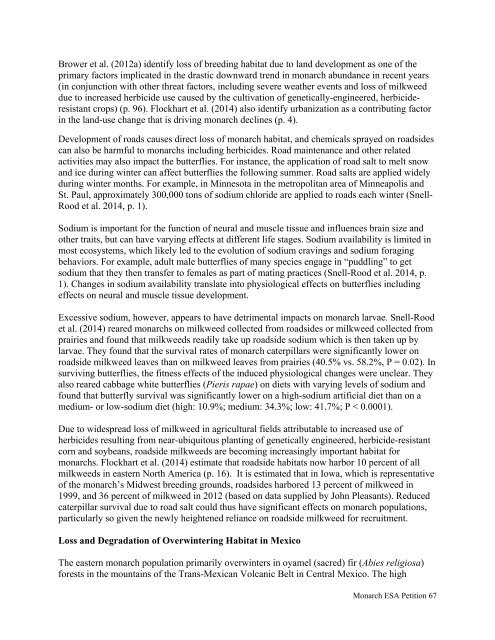monarch-esa-petition-final_61585
monarch-esa-petition-final_61585
monarch-esa-petition-final_61585
Create successful ePaper yourself
Turn your PDF publications into a flip-book with our unique Google optimized e-Paper software.
Brower et al. (2012a) identify loss of breeding habitat due to land development as one of the<br />
primary factors implicated in the drastic downward trend in <strong>monarch</strong> abundance in recent years<br />
(in conjunction with other threat factors, including severe weather events and loss of milkweed<br />
due to increased herbicide use caused by the cultivation of genetically-engineered, herbicideresistant<br />
crops) (p. 96). Flockhart et al. (2014) also identify urbanization as a contributing factor<br />
in the land-use change that is driving <strong>monarch</strong> declines (p. 4).<br />
Development of roads causes direct loss of <strong>monarch</strong> habitat, and chemicals sprayed on roadsides<br />
can also be harmful to <strong>monarch</strong>s including herbicides. Road maintenance and other related<br />
activities may also impact the butterflies. For instance, the application of road salt to melt snow<br />
and ice during winter can affect butterflies the following summer. Road salts are applied widely<br />
during winter months. For example, in Minnesota in the metropolitan area of Minneapolis and<br />
St. Paul, approximately 300,000 tons of sodium chloride are applied to roads each winter (Snell-<br />
Rood et al. 2014, p. 1).<br />
Sodium is important for the function of neural and muscle tissue and influences brain size and<br />
other traits, but can have varying effects at different life stages. Sodium availability is limited in<br />
most ecosystems, which likely led to the evolution of sodium cravings and sodium foraging<br />
behaviors. For example, adult male butterflies of many species engage in “puddling” to get<br />
sodium that they then transfer to females as part of mating practices (Snell-Rood et al. 2014, p.<br />
1). Changes in sodium availability translate into physiological effects on butterflies including<br />
effects on neural and muscle tissue development.<br />
Excessive sodium, however, appears to have detrimental impacts on <strong>monarch</strong> larvae. Snell-Rood<br />
et al. (2014) reared <strong>monarch</strong>s on milkweed collected from roadsides or milkweed collected from<br />
prairies and found that milkweeds readily take up roadside sodium which is then taken up by<br />
larvae. They found that the survival rates of <strong>monarch</strong> caterpillars were significantly lower on<br />
roadside milkweed leaves than on milkweed leaves from prairies (40.5% vs. 58.2%, P = 0.02). In<br />
surviving butterflies, the fitness effects of the induced physiological changes were unclear. They<br />
also reared cabbage white butterflies (Pieris rapae) on diets with varying levels of sodium and<br />
found that butterfly survival was significantly lower on a high-sodium artificial diet than on a<br />
medium- or low-sodium diet (high: 10.9%; medium: 34.3%; low: 41.7%; P < 0.0001).<br />
Due to widespread loss of milkweed in agricultural fields attributable to increased use of<br />
herbicides resulting from near-ubiquitous planting of genetically engineered, herbicide-resistant<br />
corn and soybeans, roadside milkweeds are becoming increasingly important habitat for<br />
<strong>monarch</strong>s. Flockhart et al. (2014) estimate that roadside habitats now harbor 10 percent of all<br />
milkweeds in eastern North America (p. 16). It is estimated that in Iowa, which is representative<br />
of the <strong>monarch</strong>’s Midwest breeding grounds, roadsides harbored 13 percent of milkweed in<br />
1999, and 36 percent of milkweed in 2012 (based on data supplied by John Pleasants). Reduced<br />
caterpillar survival due to road salt could thus have significant effects on <strong>monarch</strong> populations,<br />
particularly so given the newly heightened reliance on roadside milkweed for recruitment.<br />
Loss and Degradation of Overwintering Habitat in Mexico<br />
The eastern <strong>monarch</strong> population primarily overwinters in oyamel (sacred) fir (Abies religiosa)<br />
forests in the mountains of the Trans-Mexican Volcanic Belt in Central Mexico. The high<br />
Monarch ESA Petition 67




